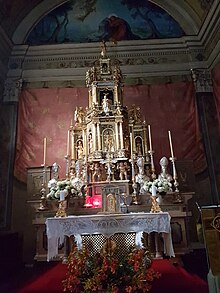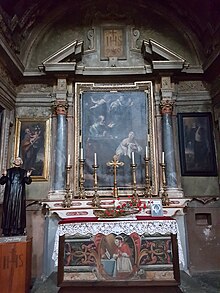San Carlo Borromeo (Brusio)
The cultural as specially protected Roman Catholic parish church of San Carlo Borromeo (also St. Charles Borromeo) stands in the center in the village of Brusio , Grisons ( Switzerland ) in the valley Puschlav (Italian Val Poschiavo ), Region Bernina , in the diocese of Chur . She is the St. Dedicated to Charles Borromeo .
history
The church was first mentioned in 1439 and rebuilt in 1617/1618 - during the time of the Reformation . Brusio has been mostly Catholic since the Counter-Reformation and still has a Reformed minority today.
In 1932, 1967/1968 and 2001 the church was renovated.
building
Outside
The building is an early baroque complex with a just closed choir, which is oriented from west (choir) to east (main entrance). The tower stands in the west in front of the choir, attached to the building on one side. The roof of the church ( saddle roof ) and the tower ( tent roof ) is covered with slates . The striking, dark gray painted, stepped buttresses and the outwardly slightly pointed skylights are late Gothic relics.
Three sides of the tower have a clock with a painted face with Roman numerals at the level of the middle sound openings .
Above the main entrance there is a facade painting of the crucified Jesus with Karl Borromeo (right) and Maria (left) at their feet. It dates from the 2nd half of the 18th century. According to the inscription, the portal itself dates from 1617.
To the south of the church, directly adjacent to the property, is the cemetery of the Catholic community.
Inside
The church has a barrel vault inside . The third yoke is flanked by low side chapels with lunette windows. The painting dates from 1932, the stucco work dates from the second half of the 18th century. The tabernacle altar (around 1625) is designed in the form of a two-storey temple, on which there are four silver-framed reliquary busts.
The altars of the side chapels are made of stucco marble ( stucco lustro ). In the church there are two altar paintings from around 1640 by Antonio Crespi Castoldi , called "Il Bustino". These show how Peter the hl. Visited Agatha in prison and the Assumption . In the north side chapel there are four panel paintings from the 17th and 18th centuries. These show St. Dominic and St. Katharina (both 17th century), St. Joseph and St. Felix von Cantalice (1730) by Giovanni Cristoforo Eysenegger . On the right wall of the nave there is a detached mural depicting the crucifixion from around 1695. This comes from the demolished rectory.
The rectangular pulpit dates from the middle of the 17th century and is decorated with carvings. The font is made of light granite and dates from around 1620–1630. It has a temple-shaped, hexagonal wooden top from the 17th century. The holy water stoup made of light stone dates from the first half of the 17th century.
The organ was installed by Marzoli e Rossi (Varese) in 1933. It comprises 16 stops on two manuals and a pedal .
Web links
Individual evidence
- ↑ KGS no .: 2889.
- ↑ See also: Roman Catholic Church in Switzerland .
- ^ A b Parish Church of San Carlo Borromeo , Art Guide Through Switzerland, Ed. Society for Swiss Art History, Volume 2, Bern 2005, last accessed on September 13, 2018.
- ↑ The above structural and time information according to: Parish Church of San Carlo Borromeo , Art Guide through Switzerland, Ed. Society for Swiss Art History, Volume 2, Bern 2005, last accessed on September 13, 2018.
- ↑ Catholic Church S. Carlo Borromeo, Brusio GR In: Orgelverzeichnis Schweiz-Lichtenstein, accessed on September 15, 2018.
Coordinates: 46 ° 15 '27.8 " N , 10 ° 7' 33.2" E ; CH1903: eight hundred and seven thousand one hundred and seventy-one / 126,469



